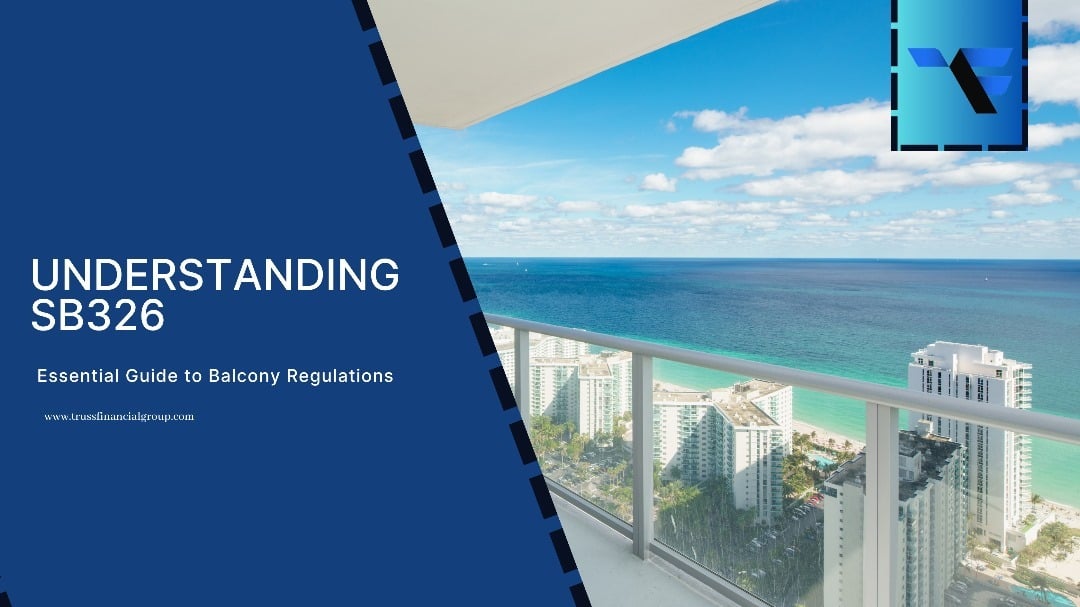12 min read

California’s SB326, also called the Balcony Bill, was passed after the 2015 Berkeley collapse to prevent hidden structural failures in condos.
It requires HOAs to inspect balconies, decks, and other elevated wooden structures for rot and water damage.
A licensed engineer or architect must complete the inspection and submit a written report by January 1, 2026, then repeat it every nine years.
-
At least 15% of all load-bearing elements must be opened and checked.
-
Civil Code §5551 enforces fines of $100–$500 per day for missed inspections.
-
Reports must go to both local officials and the HOA’s reserve study.
Skipping compliance risks fines, lawsuits, and insurance denial. Truss Financial Group offers fast, no-document HOA loans to fund inspections or repairs, helping boards act early and avoid “Do Not Occupy” orders. SB326 turns balcony safety into a financial planning priority.
A rotted joist can look fine one day and fall apart the next. California’s Balcony Bill, the new law called SB326, fights this hidden risk. It tells every HOA in a common-interest development to order a careful visual check of all high outdoor parts such as balconies, decks, landings, and elevated walkways.
A licensed structural engineer or architect must inspect load-bearing parts and the waterproof layers, then confirm that they still carry their weight safely.
The clock is ticking: the first inspection and written report are due on 1 January 2026.
Boards must send the report to the local code-enforcement office and add the findings to their next reserve-study review.
Inspections and repairs cost money. Truss Financial Group (TFG) offers quick, no-document loans to cover fees, urgent fixes, and long-term work. This lets boards act before fines, liens, or “Do Not Occupy” signs appear.
This guide covers where SB326 came from, its main rules (including the 15 percent sample rule), penalties for skipping inspections, how it differs from SB721, real cost ranges, and ways to pay.
A short checklist and FAQ give your board everything it needs to keep balconies and budgets safe.
What Is Senate Bill 326 (SB326)?
SB326 in a nutshell: This bill was Passed in 2019 after the fatal Berkeley balcony collapse of 2015.
California’s SB326 forces every condominium homeowners association (HOA) with exterior elevated elements (EEEs) such as balconies, decks, landings, and catwalks more than six feet above ground to hire a licensed structural engineer or architect to probe for hidden rot, corrosion, and water intrusion.
The first inspection was originally due by 1 January 2025 and must be repeated at least every nine years. The law’s first-principles logic is blunt: wood plus water equals failure.
2025 update, new deadline, same pressure
Assembly Bill 2579, signed 28 September 2024, shifted the initial deadline to 1 January 2026 for buildings that have not been inspected since 1 January 2019.
Lawmakers cited a shortage of qualified inspectors and pandemic-era supply-chain chaos as the reasons. What did not change:
- Civil Code §5551 still governs condos, carrying fines of 100–500 USD per day for non-compliance that can escalate into liens.
- The 15 percent sampling rule (engineers must open up 15 percent of load-bearing elements) and the 15-day emergency-hazard notice requirement remain.
- Apartment buildings covered by SB721 still face a six-year re-inspection cycle, with the first check now aligned to 2026.
California licensed roughly 2400 structural engineers last year, while about 54,000 condo complexes need thorough inspections.
Late shoppers should expect premium prices.
Origins of SB326: From Tragedy to Statute
If you live outside California, why bother?
Regulation spreads faster than termites. After the 2021 Surfside, Florida tower collapse, insurers plus Fannie Mae and Freddie Mac began conditioning loans nationwide on proof of façade and balcony safety.
Other states, especially humid coastal ones, are likely to copy SB326 language to avoid looking reckless in court. Practical fallout:
- Investors and REITs need larger reserve-study allocations and capital-expenditure budgets for condo projects nationwide.
- Lenders and insurers will demand more paperwork, tighten underwriting, and raise rates for properties lacking recent structural reports.
- Everyday condo owners will find resale disclosures increasingly ask for an EEE certificate; without one, expect a price haircut.
Key Requirements: updated for the 2026 deadline
Initial inspection (by 1 Jan 2026)
The California Legislature pushed the first-round deadline back one year when it passed Assembly Bill 2579 on 28 Sep 2024. Every condo association or home owner association (HOAs) now has until 1 Jan 2026 to inspect a statistically significant sample of exterior elevated elements (EEEs).
“Statistically significant” normally means the larger of 15 percent of all EEEs or at least one balcony, deck, or landing in every vertical “stack.”
Properties that pulled a building-permit application after 1 Jan 2020 follow a different timetable: their first inspection is nine years after the certificate of occupancy.
Nine-year cycles
After the first report, the HOA repeats the inspection every nine years so the work aligns with reserve-study review cycles.
Who Must Comply
- Buildings covered – Any condominium, co-op or planned development in California with three or more units and exterior elevated elements higher than six feet above grade whose primary load path is wood or wood-based products.
- Qualified professionals – Only California-licensed structural engineers (SE) or architects may sign the report.
Cost Realities
Reserve studies often ignore balconies until damage becomes visible. Budget early or line up an HOA loan so contributions can rise gradually instead of spiking after 2026.
Legal and Insurance Risks of Non-Compliance
- Code-enforcement orders – Local officials may post Do Not Occupy placards that wipe out property value overnight.
- Civil suits – Plaintiffs use skipped inspections to argue automatic negligence.
- Insurance denials – Carriers can refuse water-intrusion claims if no inspection file exists.
- Loan underwriting – Fannie Mae and Freddie Mac condo questionnaires now ask for balcony-safety data. Missing paperwork delays closings.
Skipping SB326 is not saving money. It is gambling with the building.
SB326 and SB721: How the Two Laws Compare
California actually runs two parallel balcony-safety laws. SB326 governs condos and co-ops, while SB721 targets rental apartments. The rules look similar at a glance, but there are critical differences that every board or landlord should understand.
Key similarities and differences
- Legal home: SB326 lives in Civil Code section 5551; SB721 sits in Health and Safety Code section 17973.
- Who must act: Condo and co-op boards handle SB326; the building owner or landlord handles SB721.
- First inspection date: Both laws now land on 1 January 2026.
- How often you re-inspect: Nine-year cycle for condos, six-year cycle for apartments.
- Reserve-study link: Condo boards must fold findings into the reserve study; apartment owners have no such tie-in.
- Who can sign the report: SB326 insists on a licensed structural engineer or architect. SB721 widens the field to include a general contractor with a “B” license.
- Penalties if you ignore the law: Expect fines, possible liens, and even injunctions under either statute.
Mixed-ownership properties must hit both targets. The smartest approach is to hire one diligent visual inspection team and rent one scaffold so you can check condo wings and rental wings during the same mobilization.
Five Questions Owners Ask Most
- Does SB326 apply to steel or concrete balconies?
Not unless wood carries the main load. Have a structural engineer put that exemption in writing. - Can in-house maintenance staff do the inspection?
No. The new law requires a California-licensed engineer or architect for SB326, and the same or a licensed general contractor for SB721. - What if the building is brand new?
If the certificate of occupancy is dated after 1 January 2020, the first visual inspection falls nine years later, not in 2026. - Will testing ruin our deck surfaces?
About ninety percent of balconies need only visual checks and moisture scans. Roughly ten percent require small exploratory cuts that are patched the same day. - Do interior shear walls or floors need inspection?
No. Both laws focus on exterior elements exposed to weather that stand more than six feet above ground level.
Case Study: Early Action, Large Savings
A 96-unit coastal condo built in 1999 decided not to wait for the deadline.
- Problem spotted: An infrared scan showed elevated moisture in twenty-two percent of balconies.
- Action taken: Engineers opened five suspect decks and discovered hidden ledger rot.
- Financing arranged: The association secured a ten-year, 1.2-million-dollar HOA loan at 6.3 percent.
- Result: Targeted repairs postponed a complete deck rebuild by roughly fifteen years, saving an estimated three-hundred-fifty-thousand dollars in today’s money.
The lesson could not be clearer: fast, financed repairs are cheaper than emergency reconstruction.
Nine Practical Steps to Get Your Community Ready
- Put a date on every calendar. Enter “Balcony inspection” for 1 December 2025 in the board’s task manager and the property manager’s work order system.
- Inventory all exterior elevated elements (EEEs). A simple spreadsheet that lists unit, square footage, height, and last repair date will do.
- Collect competitive bids. Ask at least three engineers for proposals and compare probe counts as well as pricing.
- Explain the plan to residents early. A brief email about noise, dust, and temporary balcony closures heads off panic.
- Line up the money. Pre-qualify with a lender and include loan costs in the reserve study.
- Book contractors ahead of time. Skilled decking crews now run six months out.
- Maintain airtight records. Save digital and paper copies of every report, invoice, and permit.
- Act on emergencies. If the engineer flags an Immediate Threat, block the occupant access right away.
- Tie findings back to the reserve study. Update funding levels so future boards stay solvent.
Key Takeaways You Can Act On Today
- Deadline: The initial inspection is due 1 January 2026 for condos and apartments alike.
- Expertise required: Only licensed engineers, architects, or (for SB721) B-licensed contractors can sign off.
- Inspection rhythm: Condos every nine years, apartments every six.
- Serious consequences: Fines, insurance claim denials, and stalled loans await those who ignore the statutes.
- Start budgeting now: Early financing beats last-minute special assessments every time.
Conclusion: Turn Compliance into Long-Term Confidence
SB326 and SB721 were written in blood; ignoring them is playing roulette with other people’s lives, and your property value. Get the inspection done, log every finding, and fix weaknesses before they spawn lawsuits or “Do Not Occupy” placards. That turns a state mandate into an upgrade for safety, curb appeal, and resale price.
Short on cash? Truss Financial Group lets you solve the money problem without gutting your reserve fund or begging owners for a special assessment. Their no-document HOA and apartment loans (up to $5 million) come with three practical advantages:
- No personal credit pull on unit owners, so politics stay calm.
- Interest-only periods that match construction schedules, keeping cash flow steady while scaffolds are up.
- One loan that can bundle SB326 and SB721 scopes, ideal for mixed-use buildings.
Fix the wood, not the blame. Line up your inspection team, lock in sensible financing, and head into 2026 knowing your balconies and your balance sheet are solid.
FAQ: SB326 Bill
1. What is SB326 in California?
SB326 is a balcony-safety law for condos and co-ops. It says boards must check their wood balconies and elevated walkways. The first check is due on 1 January 2026 and then every nine years. Truss Financial Group (TFG) can help in lending money so the board can pay for the work.
2. What are the SB326 inspection rules?
Hire a California engineer or architect. Look at least 15 percent of the balconies or one from each stack. Write a short report that shows the current physical condition and repair cost. If any part is unsafe, tell owners and the city within 15 days.
3. How is SB326 different from SB721?
SB326 covers condos and co-ops; SB721 covers rental apartments. Both laws start on 1 January 2026. Condos recheck every nine years; apartments every six. SB326 needs an engineer or architect; SB721 also allows a licensed general contractor.
4. What happens if you ignore SB326?
The city can fine up to $500 each day and post a “Do Not Occupy” sign. Insurance companies and banks may refuse coverage or loans. Owners can sue the board for negligence. A loan from lenders like Truss Financial Group lets you fix issues now and avoid these problems later.
Table of Content

Take your pick of loans
Experience a clear, stress-free loan process with personalized service and expert guidance.
Get a quote


.png?width=352&name=xxxxxx%20header%20(14).png)